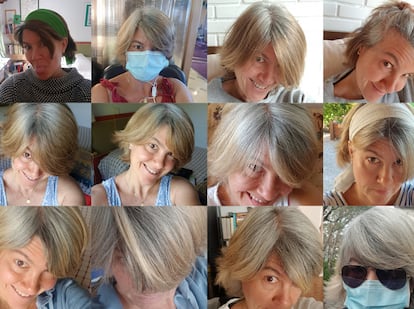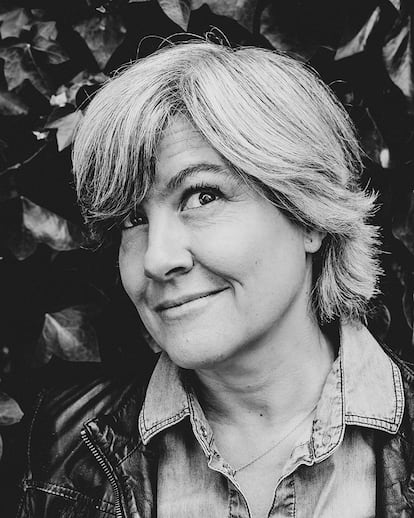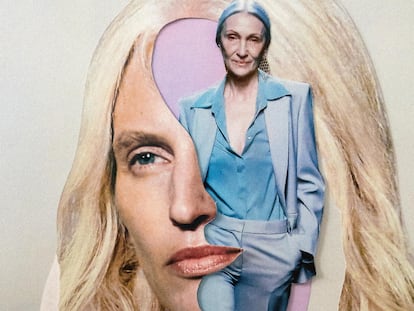How embracing my white hair gave me the confidence I never had
It has all the advantages: I don’t need to use conditioner, masks or other products to make it shine

In March 2020, I stopped dying my hair. I figured, why dye it if no one will see me and the world is ending? My gray hairs advanced uncontrollably. They found no resistance. When we could finally go on walks, I tied a scarf around my head like a headband to save others from glimpsing the intermediate stage. My girlfriends were not receptive: “Ana, I can’t let you keep your hair white. You’re going to look like a hippie religion professor, and you’ll make us all look old.” (That’s how we express unconditional love in our friendship.) My daughters, who had rejected the idea for years —”you’re going to look like a grandmother, and we already have two”— didn’t give it any importance. “You’re the same as always,” they said, confirming that they don’t pay any attention to me. I continued with my plan. In June, after four months without dying my hair, I went to the hair salon for blond touch-ups to lighten the rest of my hair and ease the transition —for everyone else, that is, because I was loving it. During the whole process, I never thought I looked ugly or unkempt or thought that I was making the wrong decision. In four months, half of my hair was completely white.
In February 1998, as I grieved the recent death of my father, I thought it would be a good idea to cut my hair, to really cut it, make a radical change. I was 24, and since age 12, I’d had a ridiculous mane that my mother cut every once in a while. I hadn’t stepped into the hair salon since going with my grandmother when I was eight or nine years old. “I’m thinking of cutting my hair,” I said out loud.
“Do something radical, Ana,” my younger brother told me. And that’s how I arrived at the hair salon that my mother sent me to and said, “Hello, I’m here to cut my hair short, but I have three conditions: I don’t want to look like an old lady, I don’t want to look like a lightbulb and I don’t use a hair dryer.” Those three instructions were the beginning of a great friendship. Twenty-five years later, Toni is still the only person who cuts my hair.
I don’t remember when I started to have gray hairs, but it wasn’t long after that haircut. White streaks appeared in my dark-brown hair, all over my head. I remember my surprise: How can I have gray hairs at 25? When I got married, three years later, my mother told me, “You should get some highlights or something to cover up your gray hairs.” (Family support is clearly hereditary in my home.) I don’t remember if I followed her advice or not, but shortly thereafter I began getting highlights to hide the gray. Then I started dying all my hair, because they weren’t streaks anymore: at 30, my whole head was white. Dying hair is exhausting. Some people love the process of getting their hair done, but for me it was torture: it meant spending three hours and €70 at the salon every two months.
If I begin dying my hair when I was 30, by 32, I started to say out loud that at 40, I would leave my hair gray. The idea was so crazy that no one paid attention. It was like I was saying, “when I’m 40, I’m going to become a Hare Krishna.” As my 40th birthday approached, I said it more and more. People started to listen and object: “You can’t do that, you’ll look older.” Older than what? I’ll look my age, no more, no less.

I spent summer 2020 wearing hats and headscarves, and by October, only the tips of my hair maintained their color. Many women have asked me how the transition was, because they don’t dare to do it. It was easy: I was determined from the beginning, and I knew it would just be a few months.
What advantages does white hair bring? All of them. I don’t use conditioner, masks or any products to strengthen it or make it shine. Once every two weeks, I use a special shampoo for white hair so that it doesn’t turn yellow. My hair is stronger, healthier and brighter. It grows faster and thicker. The most frequent comment I hear: “Your hair is incredible.” Among other unexpected consequences, having white hair has changed how I dress. Shades of blue are a hit. Large, attention-grabbing earrings fit perfectly with my new appearance. White hair has given me confidence in my appearance that I never had before.
How do others see me? To start, they see me, because white hair catches their eye. Despite the fact that it’s supposedly in fashion now, I’m usually the only woman under 70 with white hair wherever I go. With my white hair, people see me, recognize me and remember me.
A year before I decided to stop dying my hair, I had an argument with my best friend. He is the same age as I am; he doesn’t dye his hair, and he has had grayish-white hair for years. He defended the idea that “white hair ages women.” I got worked up trying to get him to understand that that idea is cultural. Advertising, movies and fashion has made us believe that only old women have white hair. On the other hand, we are inundated with images of gray-haired men who are considered mature and attractive.
Do I look older? No. I look my age. As Andy McDowell says, “I’m tired of trying to look younger.” Fifty-year-old women have gray hair, and having white hair has changed my life. I look amazing.
Sign up for our weekly newsletter to get more English-language news coverage from EL PAÍS USA Edition
Tu suscripción se está usando en otro dispositivo
¿Quieres añadir otro usuario a tu suscripción?
Si continúas leyendo en este dispositivo, no se podrá leer en el otro.
FlechaTu suscripción se está usando en otro dispositivo y solo puedes acceder a EL PAÍS desde un dispositivo a la vez.
Si quieres compartir tu cuenta, cambia tu suscripción a la modalidad Premium, así podrás añadir otro usuario. Cada uno accederá con su propia cuenta de email, lo que os permitirá personalizar vuestra experiencia en EL PAÍS.
¿Tienes una suscripción de empresa? Accede aquí para contratar más cuentas.
En el caso de no saber quién está usando tu cuenta, te recomendamos cambiar tu contraseña aquí.
Si decides continuar compartiendo tu cuenta, este mensaje se mostrará en tu dispositivo y en el de la otra persona que está usando tu cuenta de forma indefinida, afectando a tu experiencia de lectura. Puedes consultar aquí los términos y condiciones de la suscripción digital.
More information
Últimas noticias
Most viewed
- Reinhard Genzel, Nobel laureate in physics: ‘One-minute videos will never give you the truth’
- Oona Chaplin: ‘I told James Cameron that I was living in a treehouse and starting a permaculture project with a friend’
- Pablo Escobar’s hippos: A serious environmental problem, 40 years on
- Charles Dubouloz, mountaineering star, retires at 36 with a farewell tour inspired by Walter Bonatti
- Why we lost the habit of sleeping in two segments and how that changed our sense of time










































